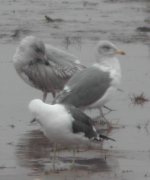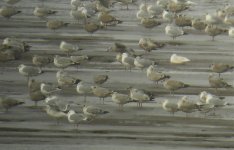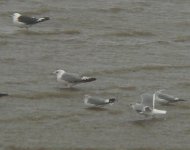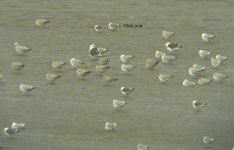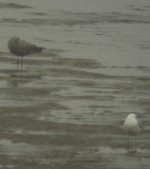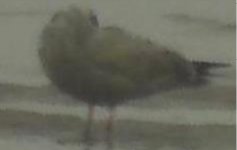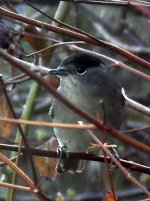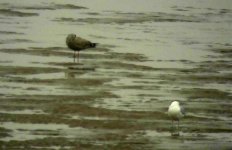-
Welcome to BirdForum, the internet's largest birding community with thousands of members from all over the world. The forums are dedicated to wild birds, birding, binoculars and equipment and all that goes with it.
Please register for an account to take part in the discussions in the forum, post your pictures in the gallery and more.
You are using an out of date browser. It may not display this or other websites correctly.
You should upgrade or use an alternative browser.
You should upgrade or use an alternative browser.
Hoylake Bird Observatory (1 Viewer)
- Thread starter Jane Turner
- Start date
More options
Who Replied?Jane Turner
Well-known member
I'd ruled out [very]small argentatus on the primary projection - it was LBBG-esque.
It was ludicrously short-legged though.
Its finding things like this when I look too hard that puts me off looking too hard!
I suspect its the bird facing away at the centre bottom of this photo
http://www.birdforum.net/attachment.php?attachmentid=306949&d=1296911725
its small and dark enough.
It was ludicrously short-legged though.
Its finding things like this when I look too hard that puts me off looking too hard!
I suspect its the bird facing away at the centre bottom of this photo
http://www.birdforum.net/attachment.php?attachmentid=306949&d=1296911725
its small and dark enough.
Last edited:
Jane Turner
Well-known member
Jane Turner
Well-known member
Have a promising gull 4th cal year - very leggy (same greeny-grey colour as the Common Gulls), very long winged, slightly darker than argenteus abd about the same as argentatus and a rather "snouty", black eye. Bill long, slender, quite green toned with black sub-terminal mark and red spot. Apparent black spot at the base of the tertials. Going out to see if I can see it better - its upwind of me and sand is blowing through the 3rd floor windows. There was plenty of black in the primary coverts and if there is a mirror in p10, its pathetic.
All the gulls are keeping as low to the sand/water as they can, but it looked very long-necked as it took flight.
All the gulls are keeping as low to the sand/water as they can, but it looked very long-necked as it took flight.
Attachments
Last edited:
Jane Turner
Well-known member
Failed to find it again, so my attempts at stringing Caspian Gull will have to wait.
Found another odd bird mind - its why I shouldn't look at them. A very dark backed large white headed bird without much of a primary projection and pink legs!
A lot of activity at sea - I must have seen Divers (all RTD) about 40 times. Plenty of Scoter, one flock containing two Mallard (67 for the year), valiantly trying to keep up.
100+ Kittiwakes out there too.
Found another odd bird mind - its why I shouldn't look at them. A very dark backed large white headed bird without much of a primary projection and pink legs!
A lot of activity at sea - I must have seen Divers (all RTD) about 40 times. Plenty of Scoter, one flock containing two Mallard (67 for the year), valiantly trying to keep up.
100+ Kittiwakes out there too.
Attachments
Hi Jane, despite the pink legs, this looks like a Yellow-legged Gull, the tone of the mantle,the size of the primary spots, structurally etc.They are not always long winged and even yellow-legged!!, although if the pink was really bright you would have to think about maybe a hybrid again.I had c40 argentatus amongst c2000 Herrings at Seaforth today and none of the adults had a clean white head.
Jane Turner
Well-known member
Hi Jane, despite the pink legs, this looks like a Yellow-legged Gull, the tone of the mantle,the size of the primary spots, structurally etc.They are not always long winged and even yellow-legged!!, although if the pink was really bright you would have to think about maybe a hybrid again.I had c40 argentatus amongst c2000 Herrings at Seaforth today and none of the adults had a clean white head.
That was my best bet based on size and structure - it was very dark - I started trying to turn the LBBG alongside into a small intermedius What did you make of the one in the post above above that - the 4th cal one one with grey/green legs
Last edited:
I hadn`t scrolled back enough to see it. Looks interesting, the eye size looks a bit big for Cach, although the distance could have made the eye surround look darker.I always think that the eyes on adult or near adult Casps look tiny and quite oriental in shape.We need to get closer views of our Gulls, most of the ones I saw today were distant , I couldn`t read the letters on the colour-ringed Med I saw. Even the three Little Gulls were c250m away. No Kittiwakes at Seaforth though.
Jane Turner
Well-known member
I failed to find it... there were some flecks on the side of the neck that haven't photographed and i don't trust the camera not to have done things to the eye... it did look small and dark in the field
Just popped it onto ID thread.
There were 200+ Kitts off Dovepoint and a Fulmar, always exciting in january.... not a blue alas.
Just popped it onto ID thread.
There were 200+ Kitts off Dovepoint and a Fulmar, always exciting in january.... not a blue alas.
deeestuary
Dee Estuary
Still large numbers of gulls of Hoylake and Meols - tried to do an accurate count and got 11,700 but that comes with a large margin of error. A bit too distant to try and do a species breakdown but reckon about 50/50 small/large gulls, large gulls mainly Herring.
KD has had 2 Med Gulls and 3 Yellow-legged Gulls over the past few days - but nothing more exciting.
KD has had 2 Med Gulls and 3 Yellow-legged Gulls over the past few days - but nothing more exciting.
Jane Turner
Well-known member
Bah humbug!
deeestuary
Dee Estuary
Hi, juv Glaucous Gull on the flat calm sea off Crosby amongst thousands of Gulls this afternoon along with 2 Yellow-legged Gulls and 4 Med Gulls.the Glauc was last seen heading over towards the Wirral....keep your eyes peeled Jane!!
Makes you wonder just how many gulls there are along north Wirral and across to Crosby! As well as the c12K at Meols there must have been at least another 2,000 off Leasowe and New Brighton plus whatever was off Crosby. The birds I saw were all counted at high tide.
I`d say there were c5000 Gulls on the sea off Crosby at high tide today...c2000 BHGs/Commons, the rest big jobs.Also of interest at Crosby marina was the smudgy headed Herring Gull again.Its got a fair amount of Smithsonianus features and has been returning here for a couple of winters, unfortunately I think it`s on the wrong side of the Irish Sea for any interest in it.( the pic of the smudgy Herring was taken a week or so ago and you can see how calm the sea was in the Glauc pic.)View attachment 307749
View attachment 307750
View attachment 307750
Last edited:
Jane Turner
Well-known member
That looks like the Hilbre bird. Why can I only see the bloody leucistic Herring Gull
yesterday there was a huge gull flock on the ebbing tide - 12-15k ish
yesterday there was a huge gull flock on the ebbing tide - 12-15k ish
Jane Turner
Well-known member
Yesterday and today, there is a Blackcap singing in the garden. Yesterday in the sun he was quite enthusiastic, but today he is deep in an elderberry bush muttering. An overhead Reed Bunting was new for the year 68
Jane Turner
Well-known member
This is what I have been doing all day - 1st draft of a description
I was sea-watching, from my 3rd floor sea-front office and half-heartedy scanning though an estimated 14,000 large Larus spp which were roosting on the water just offshore. The gulls were facing into a cold easterly wind and where hence all head on, making scanning through them a near impossible task. Just before 11am there was a disturbance in the roost to the east of me and about 4000 large gulls took to the air. I was primarily looking for a 1st winter Glaucous Gull which had been seen in the area as well as trying to relocate putative 3rd winter Caspian Gull that I’d had nearly but not quite conclusive views of on the last set of tides. Since a good number of the Gulls were now in flight, I switched to bins (8x42) since I fancied my chances of pulling out the Glauc with a wider angle view. Almost immediately I noticed a phenomenally dark 1st winter Gull with an apparently all dark tail and a paler inner primary panel.
The bird flew about 300 yards to the right of me and landed on the sea again. I could see it easily with bins, since it was so large and dark. I set up a scope (48x80) and was able to get a good view of the bird. I was able to see the bill shape and colouration well, had checked the underparts, including the vent pattern, tertials and greater-coverts. I thought I had enough to ID the bird as American Herring Gull, so I went downstairs to find my phone so I could put the news out, and my camera so I could get some record shots.
By the time I got back upstairs the gull flock had relocated further out to sea and further west. I looked for another hour and failed to locate the bird. At about 2.30pm, with the tide now dropping, a large Gull roost developed on the beach. I went through around 8000 gulls before I found a huge dark gull almost opposite the house. It was asleep and largely head on, so I can’t confirm that it was the same bird, but it was larger than nearby Herring Gulls and approaching smaller GBBGs. It was evenly dark underneath and had rather bright pink legs. It was too far out to see any details of the upperpart makings. I managed an appalling photo of the bird, then went down to pick up my phone again. When I got back upstairs, the whole flock had moved out to the low tide edge.
Description:
Jizz/size: A large and stocky gull, larger than all the predominately argenteus Herring Gulls. I didn’t see it alongside one, but I got the impression that it was of big argentatus proportions. I saw it close to GBBGs and it was close to the smallest individuals. “Mean” looking bird, with a long bill, the Glaucous Gull impression was emphasised by the colouration. The primary projection was similar to Herring Gulls – hence shorter than YLG/LBBG etc and there was quite a prominent tertial step. The legs on the second view, appeared short and strong.
Soft parts: The bill was pink based and the bill tip was black – quite like a 1st w Glaucous Gull, though will less sharp differentiation. It was possibly longer (but not strikingly) than the surrounding Herring Gulls. The legs were seen to be rather bright pink on the second view. It just shows in the photo if you use your imagination.
Upperparts: In flight the tail appeared all dark (near black) I can’t for absolute certain say that there was no fine barring at the very base of the TFs, but if there was any barring present on the base of the tail, it was similar to upper tail coverts since there was a contrast line. The rump was only slightly paler than the very dark upperparts and in flight I got an impression very like a juv Pomarine Skua, though I didn’t resolve barring with bins. Tertials: I looked carefully at the tertials – they were rather uniform, with just a narrow paler crescent at the tips. I could see clear notches on 1st W Herring Gulls alongside. The greater coverts were dark based, but there some paler marks towards the tips (distal 1/4) which formed a paler bar between the very dark bases and the secondaries. I also got the impression in flight that there was a thinner than expected mid-wing panel. The outer primaries and secondaries were near black and I could see no mirrors/apical spots. Mantle/Scaps/lesser coverts: Rather dark and more uniform than nearby Herring Gulls, though I didn’t get as far as looking at them individually. Head also rather dark.
Underparts: The entire underparts were rather dark. The neck, chest and as much of the belly as I could see on the water were apparently uniformly dark, slightly grey brown. I could see mottling on all the other juv Gulls at the same range. I looked at the vent and could see that it was slightly paler than middle of the breast and had very fine pale barring (though was predominately dark brown). On the second view I could see that the underside of the belly was also dark and that the vent was only slightly paler (though it was too far to resolve detail).
I have a couple of scruffy drawings to scan
I was sea-watching, from my 3rd floor sea-front office and half-heartedy scanning though an estimated 14,000 large Larus spp which were roosting on the water just offshore. The gulls were facing into a cold easterly wind and where hence all head on, making scanning through them a near impossible task. Just before 11am there was a disturbance in the roost to the east of me and about 4000 large gulls took to the air. I was primarily looking for a 1st winter Glaucous Gull which had been seen in the area as well as trying to relocate putative 3rd winter Caspian Gull that I’d had nearly but not quite conclusive views of on the last set of tides. Since a good number of the Gulls were now in flight, I switched to bins (8x42) since I fancied my chances of pulling out the Glauc with a wider angle view. Almost immediately I noticed a phenomenally dark 1st winter Gull with an apparently all dark tail and a paler inner primary panel.
The bird flew about 300 yards to the right of me and landed on the sea again. I could see it easily with bins, since it was so large and dark. I set up a scope (48x80) and was able to get a good view of the bird. I was able to see the bill shape and colouration well, had checked the underparts, including the vent pattern, tertials and greater-coverts. I thought I had enough to ID the bird as American Herring Gull, so I went downstairs to find my phone so I could put the news out, and my camera so I could get some record shots.
By the time I got back upstairs the gull flock had relocated further out to sea and further west. I looked for another hour and failed to locate the bird. At about 2.30pm, with the tide now dropping, a large Gull roost developed on the beach. I went through around 8000 gulls before I found a huge dark gull almost opposite the house. It was asleep and largely head on, so I can’t confirm that it was the same bird, but it was larger than nearby Herring Gulls and approaching smaller GBBGs. It was evenly dark underneath and had rather bright pink legs. It was too far out to see any details of the upperpart makings. I managed an appalling photo of the bird, then went down to pick up my phone again. When I got back upstairs, the whole flock had moved out to the low tide edge.
Description:
Jizz/size: A large and stocky gull, larger than all the predominately argenteus Herring Gulls. I didn’t see it alongside one, but I got the impression that it was of big argentatus proportions. I saw it close to GBBGs and it was close to the smallest individuals. “Mean” looking bird, with a long bill, the Glaucous Gull impression was emphasised by the colouration. The primary projection was similar to Herring Gulls – hence shorter than YLG/LBBG etc and there was quite a prominent tertial step. The legs on the second view, appeared short and strong.
Soft parts: The bill was pink based and the bill tip was black – quite like a 1st w Glaucous Gull, though will less sharp differentiation. It was possibly longer (but not strikingly) than the surrounding Herring Gulls. The legs were seen to be rather bright pink on the second view. It just shows in the photo if you use your imagination.
Upperparts: In flight the tail appeared all dark (near black) I can’t for absolute certain say that there was no fine barring at the very base of the TFs, but if there was any barring present on the base of the tail, it was similar to upper tail coverts since there was a contrast line. The rump was only slightly paler than the very dark upperparts and in flight I got an impression very like a juv Pomarine Skua, though I didn’t resolve barring with bins. Tertials: I looked carefully at the tertials – they were rather uniform, with just a narrow paler crescent at the tips. I could see clear notches on 1st W Herring Gulls alongside. The greater coverts were dark based, but there some paler marks towards the tips (distal 1/4) which formed a paler bar between the very dark bases and the secondaries. I also got the impression in flight that there was a thinner than expected mid-wing panel. The outer primaries and secondaries were near black and I could see no mirrors/apical spots. Mantle/Scaps/lesser coverts: Rather dark and more uniform than nearby Herring Gulls, though I didn’t get as far as looking at them individually. Head also rather dark.
Underparts: The entire underparts were rather dark. The neck, chest and as much of the belly as I could see on the water were apparently uniformly dark, slightly grey brown. I could see mottling on all the other juv Gulls at the same range. I looked at the vent and could see that it was slightly paler than middle of the breast and had very fine pale barring (though was predominately dark brown). On the second view I could see that the underside of the belly was also dark and that the vent was only slightly paler (though it was too far to resolve detail).
I have a couple of scruffy drawings to scan
Attachments
Jane Turner
Well-known member
Jane Turner
Well-known member
Users who are viewing this thread
Total: 2 (members: 0, guests: 2)




